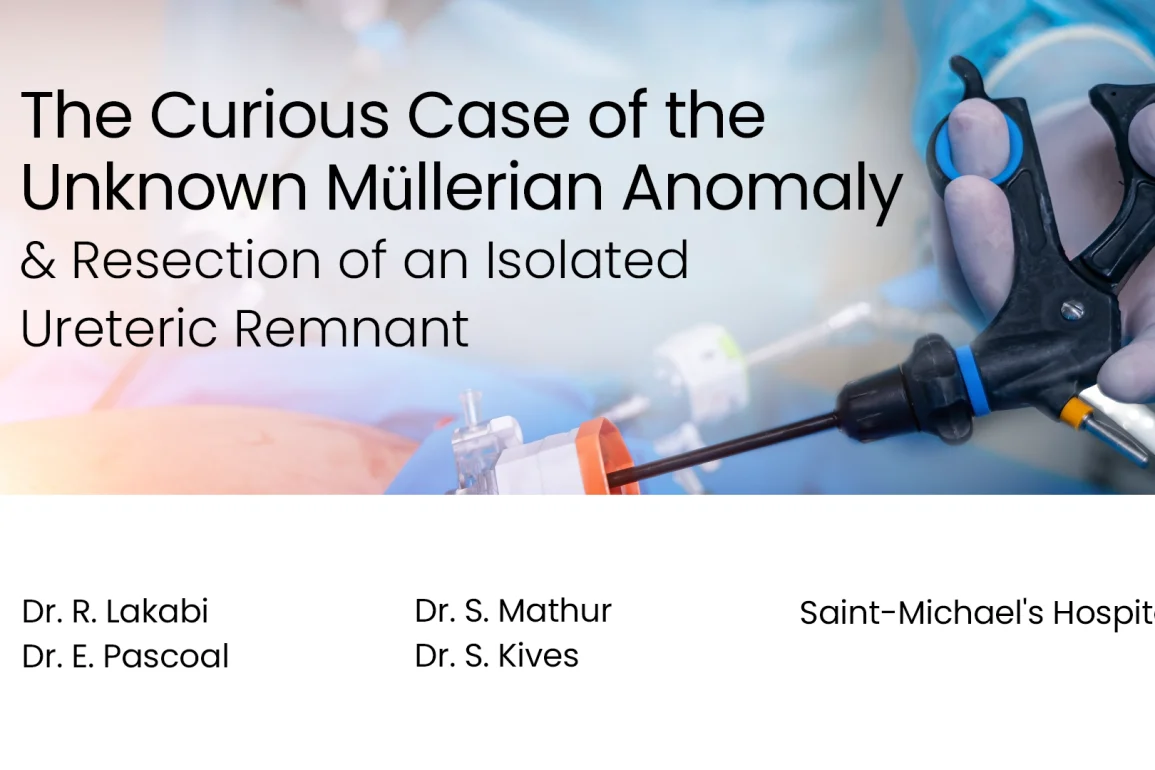Table of Contents
- Procedure Summary
- Authors
- YouTube Video
- What is Unknown Müllerian Anomaly & Resection of an Isolated Ureteric Remnant?
- What are the Risks of Unknown Müllerian Anomaly & Resection of an Isolated Ureteric Remnant?
- Video Transcript
Video Description
Explore a rare and intriguing Müllerian anomaly discovered intraoperatively, with surgical insights, imaging clues, and diagnostic challenges in gynecologic care.
Presented By
Affiliations
Saint-Michael’s Hospital
Watch on YouTube
Click here to watch this video on YouTube
What is Unknown Müllerian Anomaly & Resection of an Isolated Ureteric Remnant?
An unknown Müllerian anomaly with resection of an isolated ureteric remnant refers to the diagnosis and surgical management of rare congenital malformations involving the female reproductive tract and urinary system. Müllerian anomalies are developmental defects of the uterus, cervix, and vagina that arise from incomplete fusion or resorption of the embryologic Müllerian ducts. They can present with a wide range of findings, including uterine septa, duplicated cavities, or obstructed vaginal or cervical canals. Because these anomalies may coexist with abnormalities of the urinary tract, such as renal agenesis or ectopic ureteric remnants, careful evaluation of both the reproductive and urinary systems is essential.
What are the Risks of Unknown Müllerian Anomaly & Resection of an Isolated Ureteric Remnant?
Surgical management of complex Müllerian anomalies and ureteric remnants carries several potential complications.
- Ureteral or Bladder Injury: Dissection within the retroperitoneum places the normal contralateral ureter and bladder at risk of accidental damage.
- Vascular Injury: The uterine artery and parametrial vessels lie close to the ureteric remnant and may be injured during mobilization.
- Infection: Purulent contents within the remnant increase the risk of intraoperative contamination and postoperative pelvic infection or abscess.
- Bleeding: Dense adhesions and aberrant vasculature can cause significant hemorrhage requiring transfusion or conversion to an open procedure.
- Neurologic Injury: Dissection near the pelvic nerves may result in temporary or permanent pelvic pain or sensory changes.
- Diagnostic Challenges: Misinterpretation of imaging or incomplete intraoperative evaluation can lead to inadequate resection or persistence of symptoms.
Meticulous preoperative imaging, thorough examination under anesthesia, careful retroperitoneal dissection, and multidisciplinary collaboration are essential to minimize these risks and achieve definitive symptom resolution.
Video Transcript
Here represent the Curious Case of the Unknown Müllerian Anomaly, and Resection of an Isolated Ureteric Remnant. First we will review our case and the OHVIRA syndrome. Then we will present an approach to complex Müllerian anomalies, and to surgical resection of a symptomatic ureteric remnant.
Our patient was a 36-year-old G0 female, with a known solitary left kidney, and a history of unknown uterine reconstructive procedure. She had multiple emergency department visits, complaining of purulent and copious vaginal discharge, abdominal pain, and fever.
This was treated as PID with antibiotics, without improvement. Interestingly, the vaginal discharge resolved with oral contraceptive treatment. On exam she was found to have one cervix from which copious purulent discharge was draining. There was no evidence of a vaginal septum.
A pre-reconstructive procedure MRI showed a didelphys uterus with a short upper vaginal septum. In addition the distal aspect of the right ureteric remnant ipsilateral to the renal agenesis was connected to the upper right endocervical canal.
The post-reconstructive surgery MRI showed interval resection of the muscular uterine midline division, and findings suggestive of an OHVIRA syndrome, including an obstructed right hemivagina, an absent right kidney, and a persistent ectopic right ureteric remnant.
Pertinacious and haemorrhagic contents filled the right ureteric remnant, possibly explaining the purulent discharge. On CT urogram the serpiginous cystic tubular structure appears to terminate in the cervix, where it is quite dilated. The left kidney and ureter were normal.
Given these findings, we had two possible diagnoses. Firstly, this was a potential OHVIRA syndrome, status post unknown uterine reconstructive procedure, with a ureteric remnant draining into the endocervix or hemivagina. The other possibility was a previously complete septic uterus, after a peripheral resection, alongside an isolated ureteric remnant draining into the endocervix or the vagina.
To review, OHVIRA syndrome stands for Obstructed Hemivagina and Ipsilateral Renal Agenesis. It presents with a didelphys uterus, unilateral obstructed hemivagina, and ipsilateral renal agenesis.
When faced with complex Müllerian anomalies with unusual findings, our first step consists of uterine and renal imaging, assessing for agenesis, uterine morphology, and number of cervices. A thorough vaginal exam is necessary to assess foreign introitus, a vaginal and/or cervical septum, and the number of cervices.
Once in the operating room, a vaginoscopy and hysteroscopy is useful to assess the cervix and uterine cavity. Here we observed one cervical canal leading to one uterine cavity, with both tubal ostia visualised. At the fundus we can appreciate the remaining longitudinal uterine septum. As such, an OHVIRA was less likely.
Laparoscopically the uterine fundal indent and tubal patency can be assessed. In this case a normal fundal contour was appreciated. Tubal spill was noted bilaterally using his hysteroscopic distension fluid. These findings ruled out an OHVIRA syndrome, and confirmed a previously resected uterine septum.
Here we can appreciate the right ureteric remnant in the retroperitoneum. It will not vermiculate. Now we will discuss the resection of the isolated ureteric remnant. First the retroperitoneum is opened to access the perirectal and perivesical spaces.
Ureterolysis is performed starting at the pelvic brim, and carried down caudally. In this case, given the normal appearance of the right ureter, we obtained an intra-op urology consult to ensure that the intra-op findings correlated with the pre-op radiological findings. Right renal agenesis was confirmed, and neurology agreed with our plan to resect the right ureteric remnant.
As such, we dissected the ectopic ureter above the pelvic brim by extending the peritoneal incision cephalad. The serpiginous nature of the ectopic ureter can be appreciated here. It was dissected cephalad along its entire course, approximately 5 to 7 cm above the pelvic rim. To delineate the insertion of the remnant ureter, a ureterostomy was performed, and purulent material was noted. We then placed a guidewire and ureteric stent. Then ureterolysis was completed caudally.
Here we observed the ureteric remnant coursing through the parametria. The stent could be palpated vaginally, but was not seen by hysteroscopy nor vaginoscopy. The uterine artery was then identified, and isolated from the course of the ureteric remnant. The ureteric remnant was then resected to its base, which in our case is to its insertion to the vagina.
In conclusion, this case is a reminder that Müllerian anomalies do not always follow the textbook. Examination under anaesthesia can prove very useful in cases where there is discordance between history, radiological findings, and physical exam findings. Clinicians must remain astute to discrepancies, and consider a broad differential. A multidisciplinary approach is strongly recommended in such cases. Of note, the persistent purulent vaginal discharge of this patient resolved after this procedure.



